
In the evolving world of software development, adopting modern architecture solutions is essential for staying competitive. One such solution is Microservices. This architecture style has transformed the way we build and manage applications, offering numerous benefits. In this blog, we’ll provide an overview of microservices architecture, its benefits, challenges, and best practices for implementing these solutions for clients.
What Are Microservices?
Microservices is an architectural approach where an application is developed as a suite of small, independent services, each running its own process and communicating with lightweight mechanisms like HTTP. These services are built around business capabilities and can be independently deployed and scaled.
Benefits Of Microservices
- Scalability: Scale individual components as needed, improving resource efficiency.
- Flexibility: Use different technologies for different services, optimizing for specific tasks.
- Fault Isolation: Failures in one service don’t affect the entire system, enhancing reliability.
- Faster Development: Teams can work on different services simultaneously, speeding up development.
- Easier Maintenance: Update and fix services independently without affecting the whole system.
Challenges Of Microservices
- Complex Management: Managing numerous services can be complex and requires robust tools.
- Data Consistency: Ensuring data consistency across services can be difficult.
- Network Overhead: Inter-service communication introduces latency and potential security risks.
- Initial Setup: More initial setup and overhead compared to monolithic architectures.
Best Practices For Implementing Microservices
- Design for Failure: Implement retries and fallback mechanisms to handle service failures gracefully.
- Automate Deployment: Use CI/CD pipelines to automate deployment and testing for reliable releases.
- Centralized Logging: Implement centralized logging and monitoring for better visibility and performance tracking.
- Use API Gateways: Manage and secure API requests between clients and microservices through a single entry point.
- Containerization: Package services in containers (e.g., Docker) for consistency and easy deployment.
Real-World Example: Transforming An E-commerce Platform
The Challenge
A large e-commerce company faced performance issues and slow development cycles with their monolithic application. The single, large codebase made it difficult to scale specific parts of the system and introduced bottlenecks in development and deployment.
The Solution
We decided to transition the e-commerce platform to a microservices architecture. Here’s how we approached it:
1. Assessment And Planning
We began by assessing the existing monolithic application and identifying the key business capabilities: user management, product catalog, order processing, payment, and inventory management. We planned the transition carefully to ensure minimal disruption to the ongoing business operations.
2. Incremental Transition
We started by breaking down the monolithic application into smaller services. For instance, we created separate microservices for user management and product catalog. These services were deployed independently, allowing us to monitor their performance and make adjustments as needed.
3. Client Education
We worked closely with the client to educate them about the benefits and challenges of microservices. Regular workshops and training sessions were conducted to ensure their development and operations teams were well-prepared for the transition.
4. Collaboration And Communication
Open communication channels were maintained with the client throughout the implementation process. Weekly meetings and progress reports helped in addressing any concerns and adapting the strategy as required.
5. Continuous Improvement
Once the initial microservices were deployed, we continuously monitored their performance. We used centralized logging and monitoring tools to track the health and performance of the services. This feedback loop allowed us to make necessary improvements and optimize the system further.
The Results
- Improved Scalability: The e-commerce platform could now scale individual services based on demand. For instance, during a flash sale, the product catalog and payment services were scaled up without affecting other parts of the system.
- Faster Development: Independent development teams worked on different microservices, leading to faster release cycles and quicker implementation of new features.
- Increased Reliability: Fault isolation ensured that failures in one service (e.g., payment processing) did not bring down the entire platform, resulting in higher availability.
Conclusion
Adopting microservices can significantly transform client applications, offering scalability, flexibility, and improved fault isolation. While the transition comes with challenges, following best practices and maintaining a collaborative approach ensures successful implementation. Embrace microservices to unlock the full potential of modern software development and deliver robust, scalable, and efficient solutions for your clients.
Enhance your application’s architecture with Microservices. From increased scalability to faster development cycles, we ensure your system is robust and efficient. Ready to transform your client applications? Implement Microservices today and elevate your software solutions with confidence. Partner with AlgoRythm Solutions and take your business to the next level.


